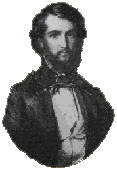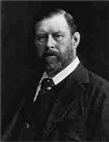

![]()
Ireland is the land of faeries, banshees,
elves, leprechauns...... and vampires. The ancient Celts practised blood-drinking
ceremonies and firmly believed in the traditions of the blood of their heroes.
The Vampire beliefs, were a later development in Celtic tradition. The two
best known beings displaying clear vampirelike characteristics on the island
are the dearg-due and the leanhaum-shee.
Dearg-due {also dearg-dul}:- a dreaded creature, whose name means 'red blood sucker'. It dates perhaps to pre-Celtic or early Celtic days. The only known way to curb its activities is to pile stones upon any grave suspected of housing such a beast.
Leanhaum-shee:- a 'fairy mistress' or deadly seductress, she is not a vampire in the traditional sense, but indulges in very vampiric activities, particularly towards her lovers. She uses her incredible beauty to lure men to her side, her irresistible charms place them under her spell. from then on the victim is drained slowly of life, wasting away as his essence is consumed by his demonic lover. the only means of breaking the spell was to find a substitute. Someone to become the next prey, the original victim then escaping.
A dearg-due is supposedly buried, in a small churchyard, near Strongbow's Tree, in the village of Waterford, County Munster. It is the story of beautiful woman who rises several times a year from the earth, using her stunning looks to lure men to their doom.
The following extract was read by WF Browne, Commissioner for Lunacy in Scotland, at the Quarterly meeting of the Medico-Psychological Association, Glasgow - 21 May 1874.
In Ireland under the savagery of Queen Elizabeth I, when the rich pastures were burned to wilderness - the miserable poor..... out of every corner of the woods and glens came creeping forth upon thin hands, for their legs could not bear them, they looked like anatomes of death; they spoke like ghosts crying out of their graves; they did eat the dead carrions; happy when they could find them; yea, they did eat one another soon after; insomuch as the very carcasses they spared not to scrape out of their very graves.
(Pg 63, Summers of the Vampire 1928, London Kegan Paul)

![]()
 Joseph Sheridan Le Fanu (1814-1873)
was born in Ireland of an old Huguenot family. He was educated at Trinity
college, Dublin and served as editor of the Dublin University Magazine,
in which a number of his works of fiction were published anonymously. He
married in 1844, becoming a recluse after the sudden death of his wife in
1858, preferring to write horror and ghost tales while in bed.Probably his
most famous short story was 'Carmilla', published in the collection
In a Glass Darkly (1872). The principal character, Countess Mircalla Karnstein,
alias Carmilla, is clearly inspired by Countess Bathory. In Victorian society
the sensual creature was perceived as the incarnation of absolute evil. It
was a story which would prove highly enduring being re-created again and
again in the movie industry of the twentieth century.
Joseph Sheridan Le Fanu (1814-1873)
was born in Ireland of an old Huguenot family. He was educated at Trinity
college, Dublin and served as editor of the Dublin University Magazine,
in which a number of his works of fiction were published anonymously. He
married in 1844, becoming a recluse after the sudden death of his wife in
1858, preferring to write horror and ghost tales while in bed.Probably his
most famous short story was 'Carmilla', published in the collection
In a Glass Darkly (1872). The principal character, Countess Mircalla Karnstein,
alias Carmilla, is clearly inspired by Countess Bathory. In Victorian society
the sensual creature was perceived as the incarnation of absolute evil. It
was a story which would prove highly enduring being re-created again and
again in the movie industry of the twentieth century.

![]()
 Bram
Stoker was born of an Anglo-Irish family near Dublin on 8th November 1847.
A sickly child he was not expected to survive, as such he spent many years
at his mothers side where he was exposed to her Irish folkloric tales. Early
in his life he expressed a desire to be writer and in November 1864 entered
Trinity College, Dublin. It was during these years that he first saw the
great actor of the time Henry Irving.. This led to him becoming a drama critic
for the Dublin Mail. Around the same time he started writing for the
'penny-dreadfuls'. Stoker became acting manager of the Lyceum Theatre in
London, during which he continued to write. Dracula was published
in London, May 1897. I was long believed he wrote it hurriedly while on holiday
in August 1895, however now it is thought his research began as early as
1890. Impressed by Le Fanu's Carmilla he carried out research in the
British Museum and Whitby Harbour. This had been the site of several shipwrecks,
including the Russian schooner Dimetry in 1885. He also visited London
Zoo, and researched, medicine, folklore etc. He originally thought about
locating the story in Styria, like Le Fanu. It is safe to say that Stoker
is the father of the modern vampire, the popular imagery being portrayed
on stage, screen and other works of literature often with little or no apparent
change.
Bram
Stoker was born of an Anglo-Irish family near Dublin on 8th November 1847.
A sickly child he was not expected to survive, as such he spent many years
at his mothers side where he was exposed to her Irish folkloric tales. Early
in his life he expressed a desire to be writer and in November 1864 entered
Trinity College, Dublin. It was during these years that he first saw the
great actor of the time Henry Irving.. This led to him becoming a drama critic
for the Dublin Mail. Around the same time he started writing for the
'penny-dreadfuls'. Stoker became acting manager of the Lyceum Theatre in
London, during which he continued to write. Dracula was published
in London, May 1897. I was long believed he wrote it hurriedly while on holiday
in August 1895, however now it is thought his research began as early as
1890. Impressed by Le Fanu's Carmilla he carried out research in the
British Museum and Whitby Harbour. This had been the site of several shipwrecks,
including the Russian schooner Dimetry in 1885. He also visited London
Zoo, and researched, medicine, folklore etc. He originally thought about
locating the story in Styria, like Le Fanu. It is safe to say that Stoker
is the father of the modern vampire, the popular imagery being portrayed
on stage, screen and other works of literature often with little or no apparent
change.
First Day Cover issued by the Irish Republic to commemorate the 150th anniversary of Bram Stoker's birth and the 100th anniversary of 'Dracula'.
A British First Day Cover commemorating 100 years of Dracula.

![]()
Although it is said Bram Stoker, based his novel, and took the name ‘Dracula’ from Vlad Dracul (Vlad the Impaler) it has never been recorded anywhere that Vlad actually drunk blood; although he is unquestionably one of the most evil figures in history. Dracul, translates as the devil, therefore Dracula is, the son of the devil. However it is also a reference to the Order of the Dragon that Vlad's father held, therefore Dracula is also Son of the Dragon.
Instead it is just as possible that he derived the name from the phrase used in Ireland for the living dead, which was literally ‘the bad blood’. The native Irish translation for this phrase is ‘Dreach-Fhola’, which obviously could easily be twisted into ‘Dracula’.

![]()
Hamilton Deane, was an Irish actor, producer and playwright.He was an acquaintance of Bram Stoker and sought a way of adapting the novel for the stage. By 1920 he was the owner of the Hamilton Deane Company, but was sill unable to find a writer to make the stage adaptation. Finally in 1923, he himself penned the three act play Dracula. The play opened in Derby, 1924 with Deane taking the part of Van Helsing. Three years later the play moved to London and the same year America. It also served as the basis for the 1931 Universal film version of Dracula with Bela Lugosi. In 1939 he took the stage as the Count. It was Deane who introduced the image of the black cape and evening dress to the role, and not Lugosi as popularly believed. As the man responsible for bringing Bram Stoker's Dracula to the stage, he is responsible for helping to create the public image of the vampire that exists today.

Legend
has it that a blood drinking vampire king is buried in a field at Slaghtaverty
outside Garvagh, County Londonderry. The story goes that the evil king, Abhartach
was slain by a rival for the throne, Cathrain. He was buried standing-up,
as was the traditional status for a king, in the field in question. He was
to re-emerge two days later, roaming the area demanding to drink the blood
of his former subjects. Once again Cathrain killed Abhartach and buried him
in the field. But once again within two days he had risen and was killing
the local people, drinking their blood.
Cathrian approached the local Druids for advice. They told
him the only way to kill the undead Abhartach was to spear him through the
heart with a sword made of yew wood. When they buried the king for the third
time, he was buried upside down, with his feet pointing at the sky. The grave
was filled with thorns and a heavy stone placed over the top to prevent him
from escaping again. After following the Druids advice for the killing and
burial Abhartach never again re-appeared.
Today the believed site stands like an island in the middle
of the field; a large stone with a thorn tree growing up the side. but belief
is still strong amongst local people that the grave should not be
disturbed.
![]()
Vampire King

![]()
American born Ann Rice, author of the Vampire
Chronicles, which are perhaps only second to Bram Stoker's Dracula
in popularity was born Anne O'Brien in New Orleans of Irish descent.
She graduated from San Francisco State University and published her first
novel, Interview with the Vampire, in 1976.